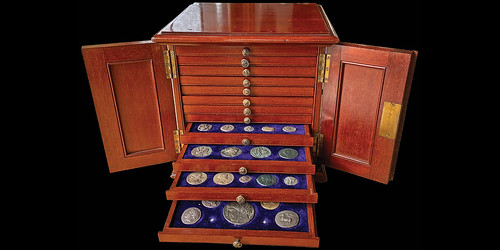
PREV ARTICLE
NEXT ARTICLE
FULL ISSUE
PREV FULL ISSUE
WHAT ARE ELECTROTYPES?Lief Davisson submitted this primer on electrotypes, inspired by an amazing lot in the upcoming Davisson's sale. Thanks! -Editor Invented in 1838, the electrotyping process involves coating a mold of the object being duplicated in a conductive material, graphite, then connecting it to a wire and running a current through it while suspending it in an electrolyte solution along with a copper anode. The copper dissolves from the surface of the anode and is deposited on the surface of the graphite mold. This process was used extensively to create plates for letterpress printing and to create accurate replicas of works of art, among other uses. It was particularly suited to creating high quality coin replicas. When duplicating coins the process creates a uniface replica of one side of the coin, which could be joined to a copy of the other side and the edges smoothed to create a more accurate replica. The copper shell was also often gilt to represent silver or gold coins more accurately. Electrotypes were widely produced by seal maker Robert Ready (1877-1901) and his sons for sale by the British Museum between 1859 and 1931, using examples from the Museum's own extensive collection. The Museum displayed these, as well as making them available for purchase and for education. Electrotypes, while convincing, are usually fairly straightforward to distinguish from the actual pieces by examining the edge for a seam, comparing the weight to an actual piece, or by a stamp of RR, R, or MB on the edge (which stand for Robert Ready, one of his sons, or the Latin name for the British Museum respectively). Barclay V. Head (1844-1914) began work at the British Museum at the age of 20 and ultimately became head of the Department of Coins and Medals. Among his extensive output of research and catalogs he summarized Ready's work, publishing a Guide to the Select Greek Coins Exhibited in Electrotype in the Gold Ornament Room in 1872 and a subsequent edition (1880) that also included Roman Coins in Electrotype in its title. The latter edition is available as a reprint. Electrotypes are an approachable and highly accurate way to represent coins that are otherwise unobtainable for most (or all) collectors. Though individual electrotypes (with sides joined or separate) can be found for sale or in auctions, comprehensive sets and electrotypes of particularly rare coins can command high prices. Of added interest are electrotype collections in contemporary or accurate displays, such as mounted on a board for schools (uniface replicas can be mounted so both obverse and reverse are visible), or in a classic display cabinet. Davissons Auction 39 features a particularly comprehensive collection in a late 19th century bespoke cabinet. Here's an excerpt from the lot description. -Editor Lot 339: Robert Ready British Museum Replica Cabinet
 A COLLECTION OF BRITISH MUSEUM REPLICAS. Two-hundred-twenty-nine electrotypes of the finest Greek coins from the British Museum holdings in a late 19th century bespoke cabinet.
Barclay V. Head (1844-1914) began work at the British Museum at the age of 20 and ultimately became head of the Department of Coins and Medals. Among his extensive output of research and catalogs he summarized Ready's work, publishing a Guide to the Select Greek Coins Exhibited in Electrotype in the Gold Ornament Room in 1872 and a subsequent edition (1880) that also included Roman Coins in Electrotype in its title. I believe the 1872 work was the basis for the numbering and layout of this collection. The latter edition is available as a reprint and we will include it with the set on request. The mahogany cabinet is 8 1/2 inches deep, 9 inches wide, and 8 ½ inches high with brass handles on the sides and doors with a latch and key. The woodwork is of the highest quality with dovetail joints, pulls with different heads from Greek coins on them, and numbered tailor-fitted depressions in velvet lined drawers that conform to the size and shape of each piece. The coin replicas were purchased joined together from the Readys with "R R" stamped on the side across the seam. The set is exceptionally well preserved. The value of this set, $20,000 to $25,000, reflects the exceptional quality of this 19th century cabinetry and the fact that all the pieces are joined and intact from the era with the RR stamp on the edge, as well as recent prices Ready electros have achieved. Several years ago CNG sold "A Mounted Set of Twenty-six British Museum Electrotypes…each uniface with attached mounting pins…mounted on velvet-lined wood" for $3250. In November 2019 Baldwins of St. James's realized a total equal to $17,000 for what they described as "A large collection of late 19th/early 20th Century electrotypes of ancient Greek and Roman gold silver and copper coins, most comprise separate obverses and reverses and are placed side-by-side in a deep front, stacking Lincoln mahogany cabinet (handles missing)." Wow! An amazing collection with a connection to numismatic literature, and even more amazing to find it intact over a century later. -Editor To read the complete lot description, see:
To read the earlier E-Sylum article, see:
THE BOOK BAZARREWayne Homren, Editor The Numismatic Bibliomania Society is a non-profit organization promoting numismatic literature. See our web site at coinbooks.org. To submit items for publication in The E-Sylum, write to the Editor at this address: whomren@gmail.com To subscribe go to: https://my.binhost.com/lists/listinfo/esylum All Rights Reserved. NBS Home Page Contact the NBS webmaster 
|
